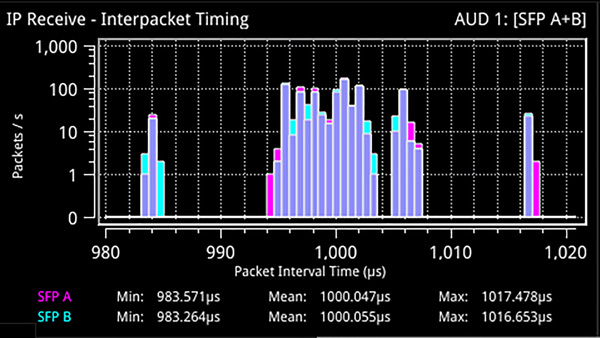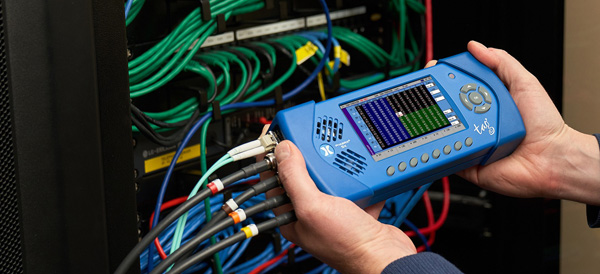PHABRIX’s Qx Rasterizer and handheld Sx TAG IP devices for signal and IP network analysis and testing were successfully self-tested against the criteria for AMWA NMOS TR-1001-1 and SMPTE 2110 at the JT-NM Spring 2020 self-test.
The JT-NM Tested Program, designed by the Joint Task Force on Networked Media (JT-NM), makes more and better documentation available to prospective purchasers of IP-based equipment, regarding how vendor equipment aligns to the SMPTE ST 2110, ST 2059 and AMWA NMOS TR-1001-1 standards and requirements. The results are published in the JT-NM Spring 2020 Self-Tested Catalogs.
Interoperability – Nodes, Standards in the Future
Phil Adams, CEO at PHABRIX said, “The purpose of the test is to ensure interoperability, and to help co-ordinate the timely introduction of support for the various parts of NMOS and ST 2110. If we have good interoperability, then customers can choose and configure components from a wide range of vendors to meet their specific requirements. Without interoperability, customers often have to go for a one vendor system instead.

“During the 2020 self-test program, numerous NMOS IS-04/05 standards use cases were discovered that required clarification. After the testing review, several key suppliers updated their products to meet these new requirements. It is still early days for NMOS but momentum is building fast.” The Discovery and Registration standard IS-04 allows media nodes and their capabilities to be discovered and IS-05, a standard for Connection Management, allows media nodes to be configured to send and receive IP streams.”
The JT-NM defined Technical Recommendation 1001-1 (or TR-1001-1) in 2018 to identify a set of key components that Media Nodes – devices or systems connected to a network – should implement. For example, the Nodes are required to implement AMWA NMOS IS-04, IS-05 and IS-09, which are defined as an appendix in TR-1001-1 and can be tested using dedicated test suites. The document also identifies key characteristics of systems that media nodes may be deployed into.
Qx Rasterizer – ST 2110 Confidence Monitoring
The PHABRIX Qx Rasterizer has a ST 2110 ‘JT-NM Self-Tested’ core set of IP functions that give operators all ST 2110 confidence status monitoring in an easily read, accessible manner. It is designed for HD IP ST 2110/2022-7 AMWA NMOS and ST 2022-6 environments, and is also useful for HD-SDI users who want to have the option to migrate to SMPTE 2110 or 2022-6 in the future.

Its core ST 2110 tools support simultaneous decapsulation – opening up of encapsulated data sent as packets over the network – of one video, two audio and one ANC data flows. Supported SMPTE protocols include ST 2059 (PTP), ST 2110-20 (Uncompressed Video), -30 (PCM Digital Audio), -31 (AES3 Transparent Transport) and -40 (ANC Data). ST 2022-7 seamless protection switching (SIPS), specifying the reconstruction of the original stream in case packets are lost in any of the paths, is available for all four flows over two media network interfaces, using industry standard 10Gbps SFP transceivers for communication between switches.
Audio handling conforms to ST 2110-30 Class C with support for 48kHz streams from 1 to 10 channels at packet times of 1ms, and 1 to 80 channels at packet times of 125us. An indication of the timing relationship is also given of each of the eight ST 2022-7 flows to PTP with status information, as well as a ST 2022-7 status tool that reports the health and relative timing skew of each ST 2022-7 pair, all with hardware time stamping.
Further Qx ST 2110 measurement tools include the simultaneous display of up to four Packet Interval Timing measurements. Users can see and track how and how far the packet intervals deviate over time from an expected value. Also included are detailed data reporting of the packet, clock rates and PTP timing relationship of the flow, advanced video timing measurements, and measurements of the ST 2110-21 Network Compatibility (Cinst) and Virtual Receiver (VRX) Buffer Models.
Mobile Testing – Sx TAG IP

The Sx TAG IP portable handheld device for broadcast IP systems carries out JT-NM Self-Tested encapsulation and decapsulation of ST 2110-20, 30, 31 and 40 packets, as well as SMPTE ST 2022-6 encapsulation/ decapsulation, using 10GE Embrionix IP SFP+ transceiver modules.
It includes IP-to-SDI gateway and ST 2059 PTP timing, following SDP and NMOS standards, plus ST 2022-6. Hybrid operation is supported with a built-in synchroniser that allows asynchronous SDI sources to be locked to PTP timing for ST 2110 encapsulation.
Sx TAG IP is compact and mobile, and versatile with SFP, SDI and analogue I/O. It suits IP, 3G/HD/SD-SDI, optical SDI, HDMI and analogue applications. www.phabrix.com





